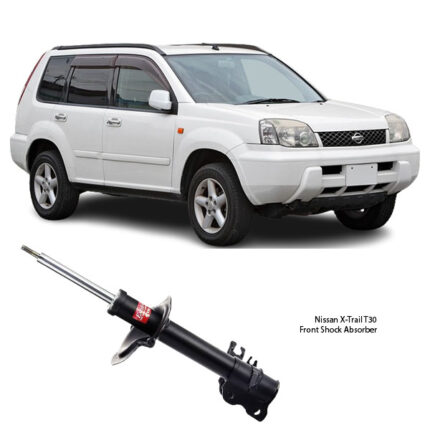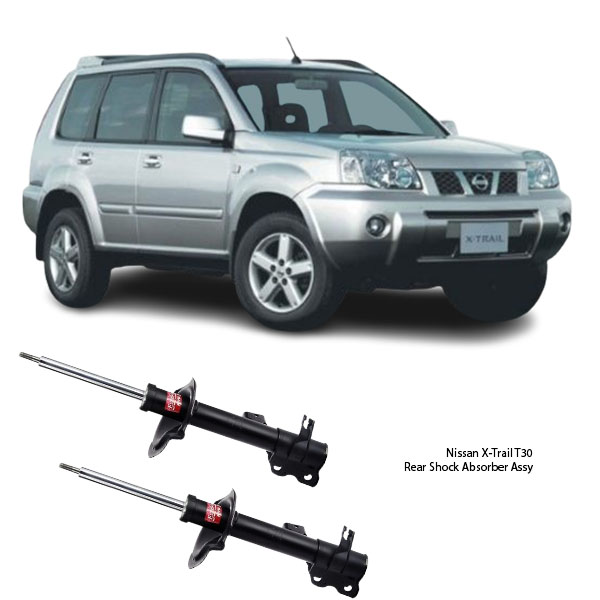-4%
Get Nissan X-Trail T30 Rear Shock Absorber Assy 334362 in Kenya
Have you ever wondered what keeps your ride stable and smooth—even when the road beneath you is anything but? It’s not just the tires or springs doing all the work. One key player silently making every journey comfortable is the Rear Shock Absorber Assembly.
Although often overlooked, rear shock absorbers are vital to maintaining ride quality, stability, and safety. They’re the behind-the-scenes guardians of control, making sure that every bump, corner, and pothole doesn’t rattle your ride—or your peace of mind.
Let’s take a closer look at what makes this component essential, how it works, and why keeping it in good condition can make all the difference. 🧰🚙🌍
🔧 What Is a Rear Shock Absorber Assembly?
The Rear Shock Absorber Assembly is part of a vehicle’s suspension system. Mounted between the rear axle and the chassis, it works with the coil springs to control motion and absorb energy from road irregularities. Where the spring handles the bounce, the shock absorber handles the rebound.
When your vehicle hits a bump, the spring compresses to absorb the energy. Without a shock absorber, that spring would continue to oscillate—causing the vehicle to bounce uncontrollably. The rear shock absorber assembly dampens that motion, ensuring stability and comfort.
A typical assembly includes:
-
🛠️ A piston rod and cylinder
-
💧 Hydraulic or gas-filled chamber
-
🔩 Mounting bushings
-
🧱 Sometimes integrated with a coil spring (shock/strut combo)
Its job? Simple yet critical: Smooth the ride and keep your wheels in contact with the road.
🌊 How It Works
Inside the shock absorber, a piston moves through hydraulic oil (or sometimes gas), passing through precisely engineered valves. When your suspension compresses or rebounds, the movement of the piston generates resistance, converting kinetic energy into heat. 🔥
This resistance slows down the motion of the spring, preventing excessive bouncing or swaying. And because the rear wheels follow the road your front wheels just passed, the rear shocks play a crucial role in keeping everything settled and steady.
Here’s what happens in real-time:
-
🛞 Rear wheel hits a bump
-
🔁 Spring compresses and rebounds
-
💦 Shock absorber dampens the motion
-
🧘♂️ Result: Smooth, controlled movement
💡 Why Rear Shocks Matter
While front shock absorbers handle steering and direct impact, rear shock absorbers are the key to maintaining balance and ride quality, especially when the vehicle is loaded or under stress.
Benefits include:
-
🧘♂️ Smoother ride for passengers and cargo
-
⚖️ Balanced weight distribution
-
🧭 Improved vehicle handling
-
🛞 Reduced tire wear
-
🧯 Shorter stopping distances
-
🛠️ Less strain on suspension components
Rear shocks don’t just keep the ride comfortable—they make it safe.
⚠️ Signs of Worn Rear Shock Absorbers
Shock absorbers wear out slowly, and most drivers adapt without even realizing it. But there are warning signs that tell you it’s time to inspect or replace them:
-
🛞 Bouncing after hitting bumps
-
🌀 Body roll or sway during turns
-
🪫 Sagging rear end when loaded
-
🔊 Clunking noises from the rear
-
🌊 Fluid leaks around the shock body
-
🚫 Reduced traction on uneven roads
-
📉 Inconsistent tire wear
When your shocks can’t keep the wheels planted, your entire ride—and your safety—is compromised.
🧪 What Causes Rear Shocks to Fail?
Rear shock absorber assemblies are built to endure harsh conditions, but several factors can shorten their lifespan:
-
🏚️ Rough or unpaved roads
-
🚚 Frequent heavy loads
-
🌧️ Water, mud, and road salt
-
🕐 Wear and tear over time
-
🛠️ Low-quality replacements or improper installation
Though some shocks last 100,000 km or more, performance will gradually degrade. Regular checks help you catch issues early and keep your ride smooth.
🔄 When Should They Be Replaced?
There’s no hard rule, but a good guideline is to replace rear shocks every 60,000 to 100,000 km, or sooner if you notice performance decline. If one shock is bad, replace both to maintain balance and symmetry in the suspension system.
Why? Because uneven damping between the left and right rear sides can lead to instability and dangerous handling characteristics. Better safe than sorry.
🛠️ What’s Involved in Replacement?
Replacing a rear shock absorber assembly is a relatively straightforward process, especially when done by professionals.
Here’s what the job typically involves:
-
🔧 Lifting the vehicle safely
-
🔩 Removing the old shocks
-
🧽 Cleaning the mounts
-
🆕 Installing new assemblies
-
🧰 Torqueing all bolts to spec
-
🛞 Test driving to check balance and handling
Most of the time, the difference is noticeable immediately. Smoother rides. Better control. Less noise.
🌟 Benefits of New Rear Shock Absorbers
Once installed, fresh rear shocks transform your driving experience. Benefits include:
-
💺 Immediate improvement in ride comfort
-
🔄 Reduced bounce and sway
-
📏 Balanced vehicle stance
-
🚘 Quieter, more refined ride
-
🛞 Improved traction and braking
-
🔧 Lower maintenance on related parts
Your vehicle will not only feel newer—it will respond better, too.
🧼 How to Extend the Life of Rear Shocks
Good driving habits and regular checks go a long way in preserving your shocks. Here are some helpful tips:
-
🚧 Avoid sudden impacts like potholes or curbs
-
📦 Don’t overload your vehicle
-
🧽 Wash the underside to prevent rust and buildup
-
🔍 Inspect for leaks and wear regularly
-
🛠️ Use high-quality parts during replacements
Remember, your shock absorbers don’t just affect comfort—they affect every aspect of control.
🔚 Conclusion: Smooth, Safe, and Steady All the Way 🌈🛞
Your Rear Shock Absorber Assembly may not be visible from the driver’s seat, but it’s working hard every second to ensure your ride is smooth, safe, and balanced. It takes the hits so you don’t have to. It keeps your tires grounded. It protects your suspension system and delivers that perfect balance of comfort and control.
When maintained and replaced on time, rear shocks can give your vehicle a renewed sense of stability and performance. And when ignored? You’ll feel every bump, lose control in corners, and wear out your tires faster.
So the next time you’re enjoying a smooth, effortless ride—know that your rear shocks are quietly doing their job, one bump at a time.
Follow us on Facebook for more parts.



